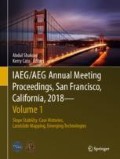Abstract
Since the 19th century, the warming rate in the European Alpine region has been twice as high as the average global rate. Warming-related permafrost degradation has been shown to cause a reduction of bedrock bearing capacities, potentially leading to the destabilization and eventually to the failure of high-alpine infrastructure. The presented study investigates permafrost-related changes of bedrock properties and their stability-relevant effects on high-alpine infrastructures. The Kitzsteinhorn summit and its highly frequented cable car station (3029 m a.s.l., Austria) is home to the interdisciplinary Open Air Lab Kitzsteinhorn (OpAL), where the consequences of climate change, based on a long-term monitoring of surface, subsurface and atmospheric parameters are investigated. In a rock-ice mechanical model, degradation of permafrost causes changes in rock fracture toughness and rock friction, affects ice fracturing and creep as well as the behavior of rock-ice interfaces. A first numerical distinct element model of the mechanical behavior of rock slope and the infrastructure was set up, based on OpAL datasets and a civil engineering assessment of the cable car setup. By conducting a thorough rock mechanical model sensitivity analysis, it was tested how individual model parameters affect the rock slope stability below the cable car summit station. The accurate knowledge of the most sensitive parameters and their empirical variation range generates a better process understanding of destabilisation in permafrost-affected rock walls. This facilitates efficient stabilization measures for affected high-alpine infrastructures. Here we show, that the stability of infrastructure on permafrost-affected bedrock is not only passively determined by mechanical changes in the underlying frozen rock mass, but infrastructure also actively affects thermal conditions and rock stability in a relevant way.
Access this chapter
Tax calculation will be finalised at checkout
Purchases are for personal use only
References
Barton, N.: A model study of rock-joint deformation. Int. J. Rock Mech. Min. Sci. Geomech. Abstr. 9, 579–582 (1972)
Bommer, C., Phillips, M., Arenson, L.: Practical recommendations for planning, constructing and maintaining infrastructure in mountain permafrost. Permafrost Periglac. Process. 21(1), 97–104 (2010)
Davies, M., Hamza, O., Harris, C.: The effect of rise in mean annual temperature on the stability of rock slopes containing ice-filled discontinuities. Permafrost Periglac. Process. 12(1), 137–144 (2001)
European Environment Agency: Regional climate change and adaption. The Alps facing the challenge of changing water resources. Luxembourg (2009)
Fischer, L., Kääb, A., Huggel, C., Noetzli, J.: Geology, glacier retreat and permafrost degradation as controlling factors of slope instabilities in a high-mountain rock wall: the Monte Rosa east face. Nat. Hazards Earth Syst. Sci. 6, 761–772 (2006)
Geoconsult ZT GmbH (12.12.2010): Kartierung Gipfelstation. Salzburg, Austria (2010)
Geoconsult ZT GmbH (20.03.2014): Sicherungsplanung der Felsflanke unterhalb der Gipfelbahn. Salzburg, Austria (2014)
Günzel, F.: Shear strength of ice-filled rock joints. In: Kane, D.L., Hinkel, K.M. (eds.) Proceedings of the 9th International Conference on Permafrost, Fairbanks, Alaska, pp. 581–586 (2008)
Hartmeyer, I., Keuschnig, M., Delleske, R., Schrott, L.: Rockfall in permafrost-affected Cirque Walls: new insights on spatial variability and potential causes derived from a 4-year LiDAR monitoring campaign. Kitzsteinhorn. Austria. In: Speech at 11th International Conference on Permafrost, 20–24 June 2016. Potsdam, Germany (2016)
Krautblatter, M., Funk, D., Günzel, F.: Why permafrost rocks become unstable. A rock-ice-mechanical model in time and space. Earth Surf. Process. Land. 38(8), 876–887 (2013)
Voigtländer, A., Scandroglio, R., Krautblatter, M.: Entwicklung geotechnischer Felsparameter des Kitzsteinhorner Kalkglimmerschiefers – Abschlussbericht zum Forschungs - und Entwicklungsvertrag der TU München und AlpS-GmbH. München, Germany (2014)
Author information
Authors and Affiliations
Corresponding author
Editor information
Editors and Affiliations
Rights and permissions
Copyright information
© 2019 Springer Nature Switzerland AG
About this paper
Cite this paper
Pläsken, R., Krautblatter, M., Keuschnig, M. (2019). Analyzing the Sensitivity of a Distinct Element Slope Stability Model: A Case Study on the Influence of Permafrost Degradation on Infrastructure Stability. In: Shakoor, A., Cato, K. (eds) IAEG/AEG Annual Meeting Proceedings, San Francisco, California, 2018 - Volume 1. Springer, Cham. https://doi.org/10.1007/978-3-319-93124-1_10
Download citation
DOI: https://doi.org/10.1007/978-3-319-93124-1_10
Published:
Publisher Name: Springer, Cham
Print ISBN: 978-3-319-93123-4
Online ISBN: 978-3-319-93124-1
eBook Packages: Earth and Environmental ScienceEarth and Environmental Science (R0)

